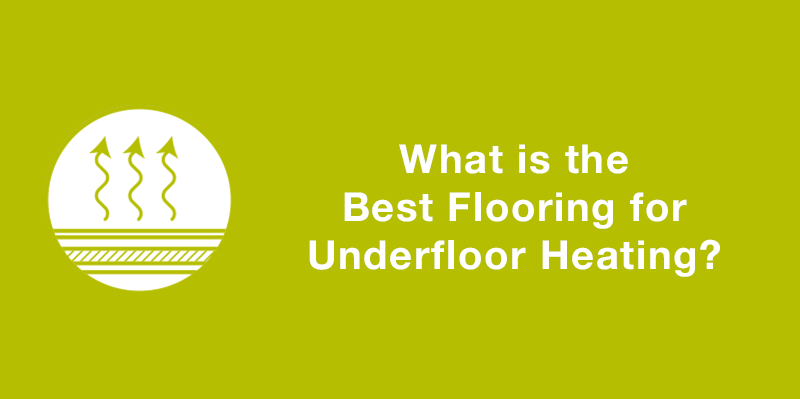What is the Best Flooring for Underfloor Heating

When discussing the best flooring for underfloor heating, there are many aspects to consider, such as thickness and heat retention. However, the most important is how easily the flooring material lets heat pass through or, for short, thermal conductivity. The best flooring for underfloor heating will have the highest thermal conductivity. High thermal conductivity will give you the benefit of faster heat-up times and less energy required to maintain a certain level of heat, making your system more efficient overall. Don’t worry; this does not mean radiant heating systems will not work with less conductive flooring materials. In fact, there is an underfloor system for almost every type of flooring! In this article, we will cover everything you need to know about radiant floor heating and how to choose the right floor covering to go with your system.
Tile & Stone
Due to their high thermal conductivity, tile and stone are the best choices available for underfloor heating. Not only do they let heat pass through very quickly, but they also retain the heat well, resulting in running your system less. They also have the highest maximum temperature, capable of reaching up to 84 degrees Fahrenheit and sometimes more. If you are looking for a system with the fastest possible heat up time, you should also consider going with a thin tile. As a general rule, anything over 3/4″ thickness will begin to slow your heat-up times.
We recommend QuietWarmth Peel and Stick. QuietWarmth Peel and Stick uses conductive ink technology instead of traditional wiring inside mesh mats. This technology not only provides a more evenly heated floor but is also thinner than a credit card. This prevents any change in floor height and prevents you from dealing with any extra self-levelers or messy mortars. The same-day installation capability will allow you to peel and stick the mats to the sub-floor and begin tiling!
Vinyl Flooring
Vinyl flooring performs well as a conductor for underfloor heating. Since most vinyl floors are thin, it heats up and cools down quickly. Vinyl flooring is waterproof, helping prevent moisture issues. Vinyl floorings biggest set back is its temperature restriction. In general, vinyl flooring should not reach over 80.6 degrees Fahrenheit. It is important to check the vinyl manufacturer’s installation instructions for the specific temperature limit.
Laminate Flooring
Laminate has been a popular flooring option for the last 20 years. It’s cost-effective, easy to install, and can visually suit any decor need because one can find it in all shades. Laminate flooring will work well with underfloor heating; one needs to be a little extra careful when choosing their laminate flooring. Laminate tends to be thicker and denser than luxury vinyl flooring. You will want to ensure thermal conductivity. The thinner the laminate is, the quicker the heat up time will be, and the more responsive your system will be.
Wood Flooring
There are many different types of wood flooring that each have different thermal properties. Density and thickness are the two factors you will want to consider when looking for compatible wood flooring. The more dense and thin the boards are will typically mean increased thermal conductivity.
Hardwood
Hardwood tends to be prone to temperature and humidity changes. Too drastic of changes can cause crowning, gapping, and cupping. If you want to install underfloor heating with hardwood flooring make sure to check with the flooring manufacturer about compatibility.
Engineered Timber
Engineered timber handles changing floor temperature and humidity levels well making it the best wood floor for underfloor heating.
Bamboo
Bamboo is another notable wood flooring material for use with underfloor heating. It has a similar construction to engineered wood. It is also much denser than most hardwoods giving it a good thermal conductivity.
Rubber Flooring
Rubber flooring will depend on what kind of rubber flooring you choose. Solid rubber flooring normally is very conductive and has excellent thermal properties. However, some rubber floorings have been known to give off an odor when used with radiant heat. It is important to consult the manufacturer of the rubber flooring company to find out about its compatibility.
Carpet Flooring
Although there are better options for underfloor heat out there, carpet is still viable. The carpet material must not act as an insulator that blocks most of the heat. Your best bet is to choose a thinner carpet that is not designed to insulate. Once again, it is best to check with the manufacturers to ensure compatibility.
Bottom Line
No matter what type of flooring you wish to install, it is important to check both the manufacturer’s instructions and the underfloor heating manufacturer’s instructions. The manufacturer will most likely state the wood’s compatibility with radiant heat inside its installation instructions. If not, it is worth it to contact the manufacturer to be certain when dealing with a big investment like new flooring.
Join Our Newsletter
You are about to install your new flooring. As you lay the first plank you realize that
